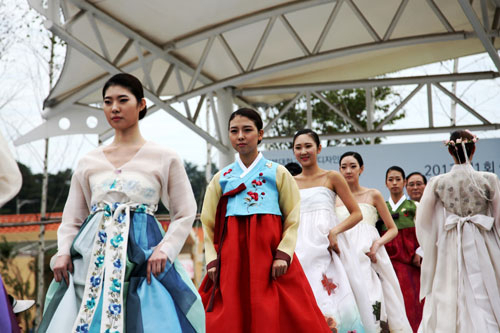The flower-like 'Hamchang Silk' luxury revival... Sangju
페이지 정보
작성자Hursilks 댓글 0 조회 28 작성일 13-12-27 16:31본문
At the Hamchang Silk Festival held at the Hamchang Silk Theme Park in Sangju last September, models show off Hanboks made with Hamchang Silk. / Correspondent Go Do Hyun
Sangju 'Hamchang Myeongju', which has adhered to the traditional manufacturing method for thousands of years, is emerging as the representative brand of Sangju following Sangju Dried Persimmon.
This is because more and more consumers are looking for Hamchang silk, which is famous as one of the three representative traditional fabrics in Korea along with Hansan ramie and Andongpo.
Pongee clothes, also called silk, have been precious since ancient times to be a symbol of wealth or success, but with the advent of synthetic fibers such as nylon, polyester, and acrylic in the 1970s, they almost disappeared. However, it succeeded in creating a new luxury product by meeting natural dyeing, and it is in the limelight as a material suitable for hanbok and women's clothing.
◆A national brand that has been around for thousands of years
Sangju is well-known as the home of three white things: rice, dried persimmons, and silkworm cocoons, and it is also because of the existence of 'Hamchang Silk'. Hamchang silk is silk produced mainly in Hamchang-eup and some areas of Ian-myeon, Sangju-si, and currently accounts for about 95% of traditional Korean silk.
Korea's modern sericulture industry enjoyed its heyday in the 1970s. At this time, Sangju, the center of sericulture, harvested mulberry leaves from 2,180 hectares of mulberry fields, raised 36,225 boxes of silkworms (one box contains about 20,000 silkworm eggs), and produced 1,090 tons of silkworm cocoons. Since then, sericulture, which began to be pushed by synthetic fibers, declined rapidly, and in the mid-1980s, production of raw silk (thread from silkworm cocoons) in Korea virtually ceased.
Although textile weaving machines have evolved to become more and more convenient and highly productive, Hamchang silk farmers have not broken the tradition, sticking to the traditional silk weaving method. The reason farmers stick to the traditional loom method is that looms used in general textile factories cannot bring out the characteristics of silk.
◆Resurrection through encounter with natural dyeing
The encounter with natural dyeing of silk 10 years ago served as an opportunity to bring about the revival of the Sangju silk industry. It is so unique that it is difficult to imitate the color of naturally dyed silk even with chemical dyes that produce accurate and vivid colors. The encounter between silk and natural dyeing became an opportunity to introduce fashion into Hamchang silk, which was used as a veterinary cloth.
More and more people are looking for hanbok (traditional Korean clothes), such as skirts and jackets made with naturally dyed silk, pants, and scrolls, as well as scarves and other accessories. In particular, scarves and fabrics dyed with persimmon water on traditional silk have been reborn as unique patterns that are only one in the world, and their rarity value is recognized. Persimmon dyed silk fabric made by hand produces completely different patterns depending on natural conditions such as sun, wind, water, and time in the process of coloring even if it has the same design. There is a charm.
Heo Ho (56, CEO of Heo Si Silk), who was selected as the best artisan in Gyeongsangbuk-do, said, "I thought that not being able to make the same product would be a drawback, but now that there is only one fabric in the world, Hamchang silk is selling better because of its uniqueness." .
22 members of the silkworm farming association in Hamchang, Sangju, sold 150,000 pieces of silk last year, posting an all-time high of 15 billion won in sales. It is solidifying its position as the nation's best silk farmhouse to the extent that most of Gyeongsangbuk-do's hundreds of millions of silk farmhouses are concentrated in this corporation.
◆Creation of Myeongju Theme Park and establishment of National Hanbok Promotion Agency
Gyeongsangbuk-do and Sangju-si joined hands for the revival of Hamchangmyeongju. Starting with the opening of the Hamchang Silk Museum in Gyochon-ri, Hamchang-eup in April, Sangju City laid the groundwork for the sluggish sericulture industry to recover by creating a silk theme park that integrates the entire process from breeding silkworms to producing silk products. About 900 million won is being invested intensively in the creation of mulberry fields, improvement of silk looms, and development of health functional foods.
In September, Gyeongsangbuk-do relocated the Jamsa Insect Plant to the Myeongju Theme Park, laying the foundation for fostering it as a mecca for the sericulture and insect industries that will lead the next 100 years. The Jamsa Insect Plant has a total building area of 5,918m2 on a land area of 149,000m2, and is equipped with a main building, research and testing building, jamsil, silk production building, and silkworm experience center.
In particular, Gyeongbuk-do and Sangju-si are moving to attract the 'National Korea Hanbok Promotion Agency' to Sangju. The two sides recently set up a plan to establish a Hanbok Promotion Institute in Myeongju Theme Park in Hamchang-eup with a project cost of KRW 25 billion (including government funds) to develop the Hanbok industry and nurture manpower, and recently signed an agreement with the Establishment Promotion Committee of the Hanbok Promotion Institute (Chairman Park Hyeon-joo) for joint promotion. has signed
Sangju Mayor Seong Baek-young said, “The need to create a base that can spread our hanbok culture has been constantly raised. We plan to use it as a training center," he said.
Related Links
- http://news.imaeil.com/page/view/2013122707033785112 14 connection

 LANGUAGE
LANGUAGE





